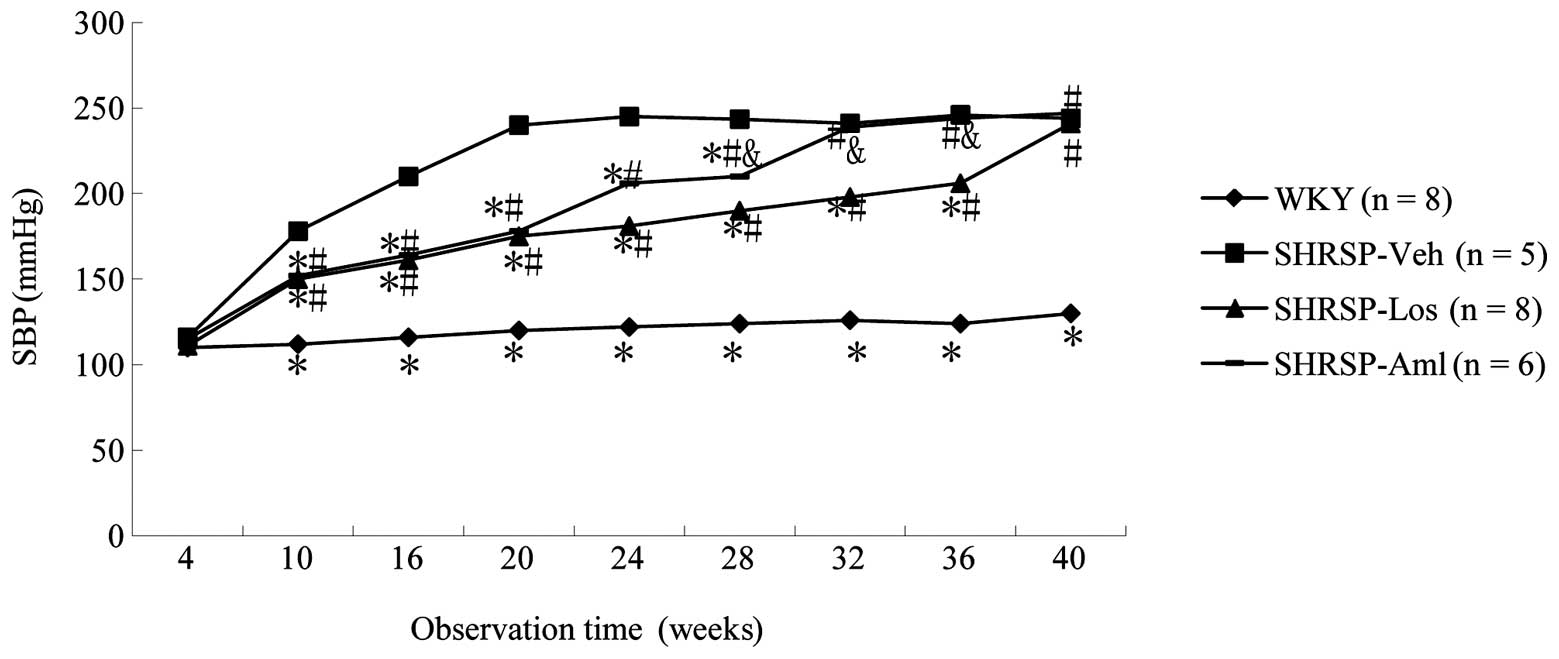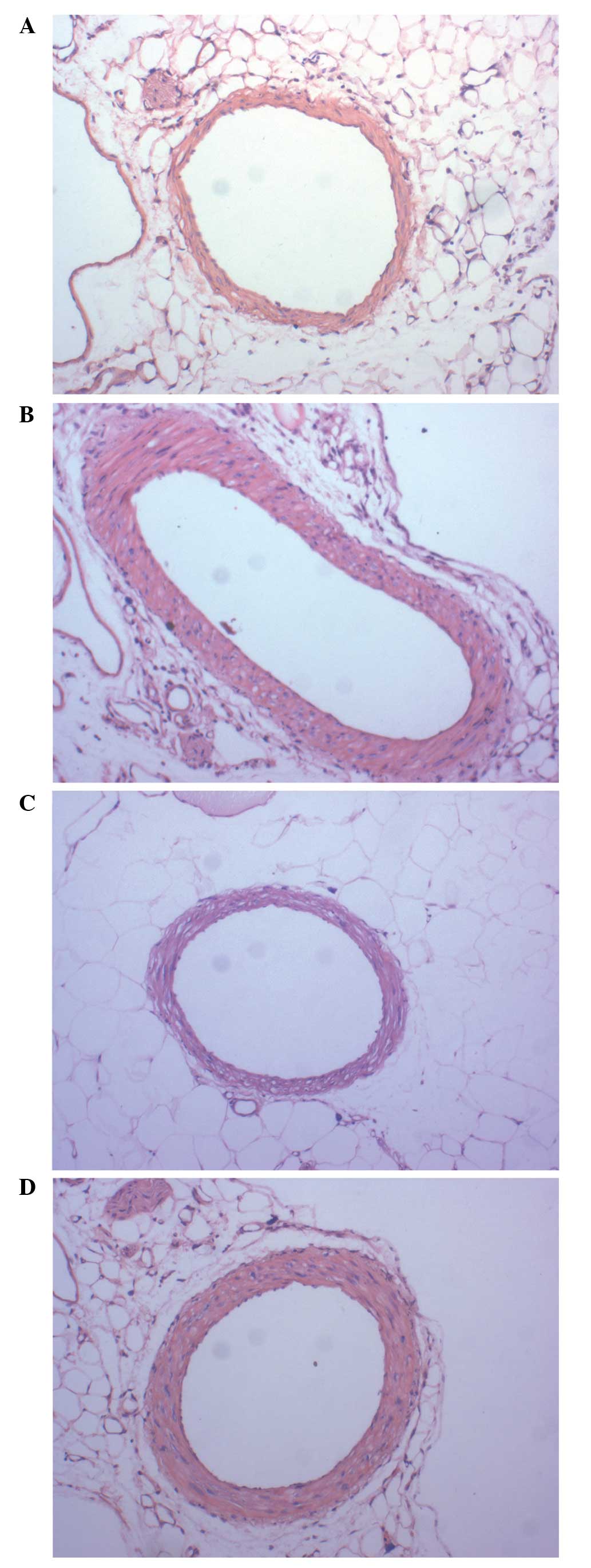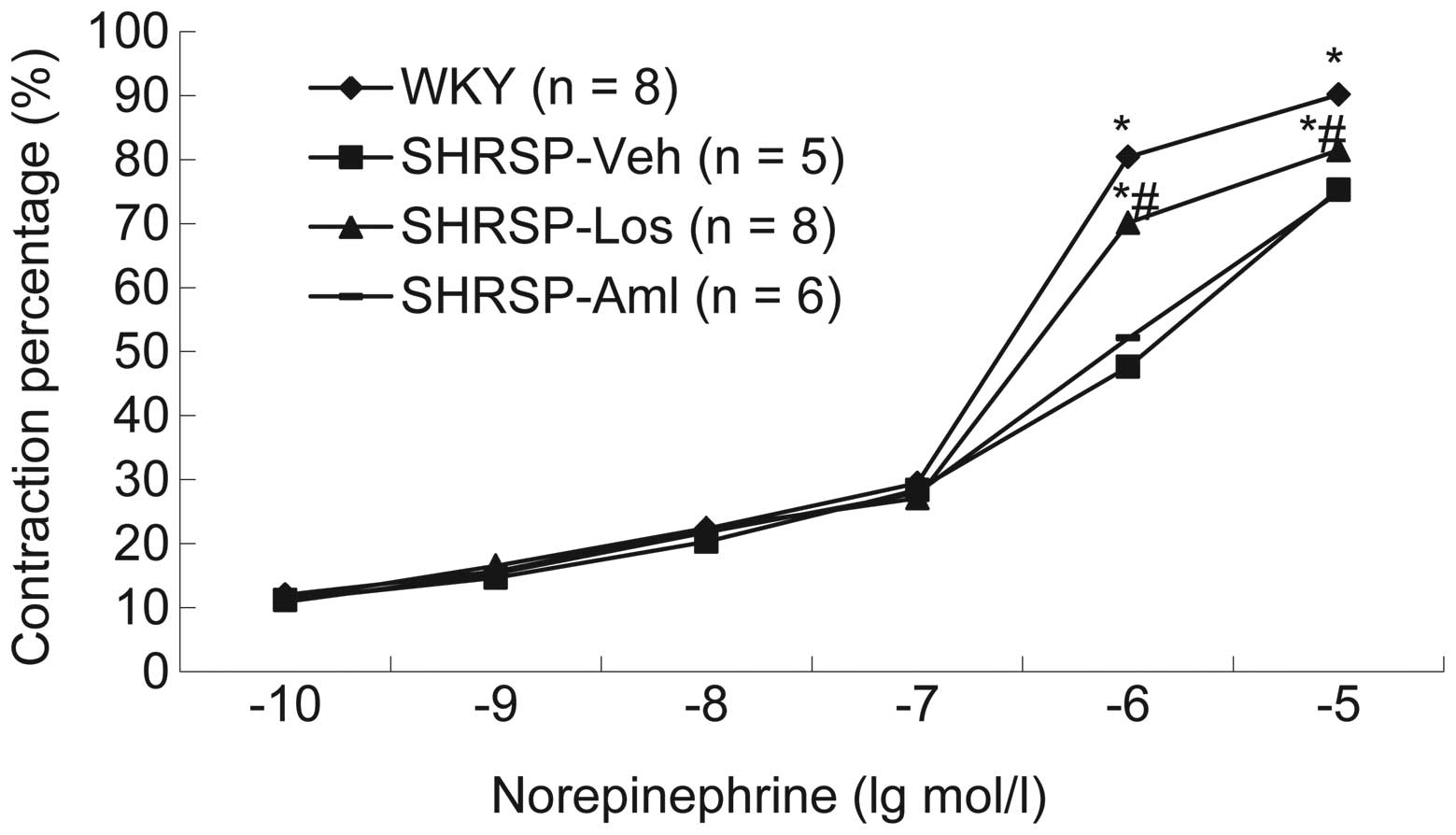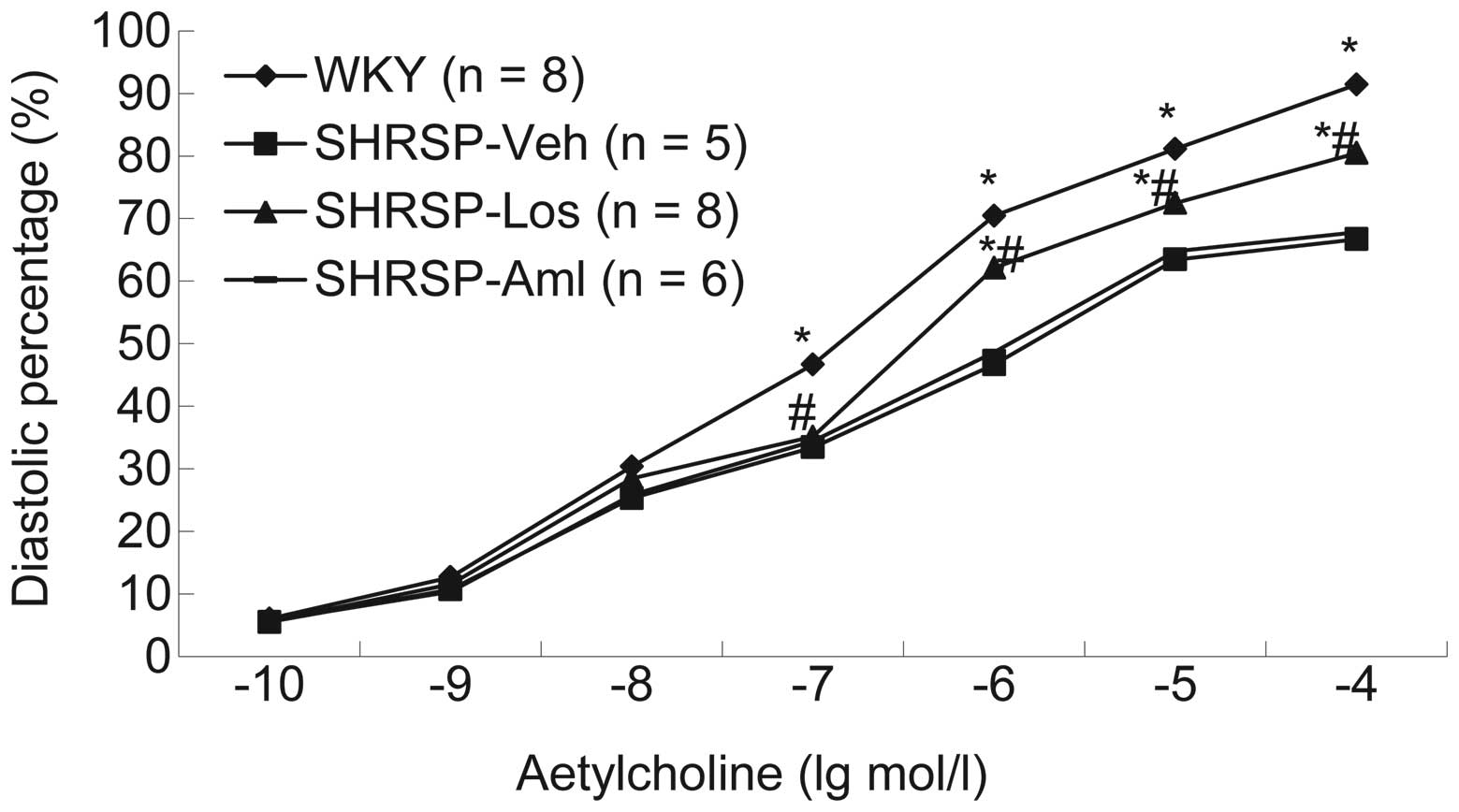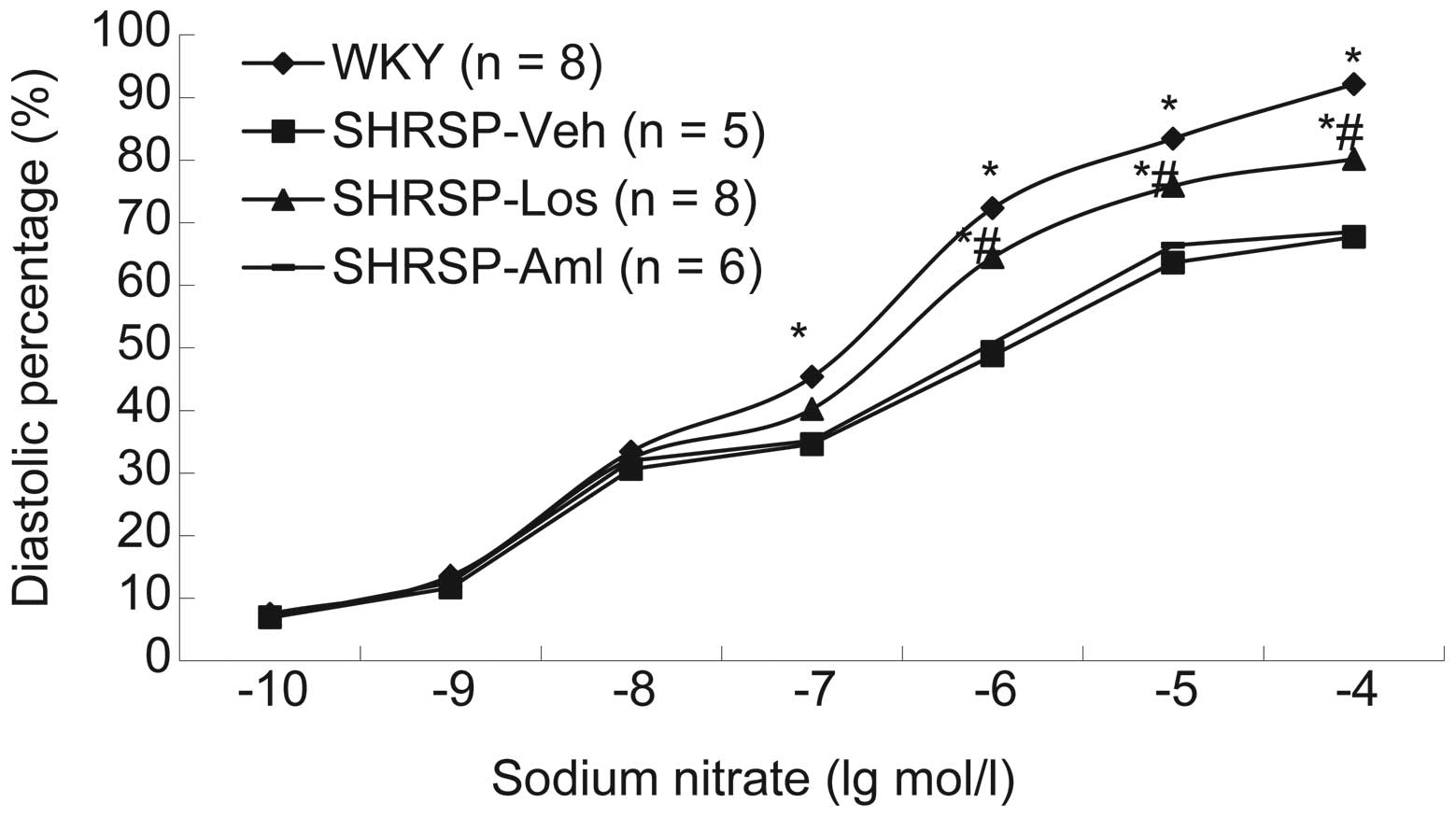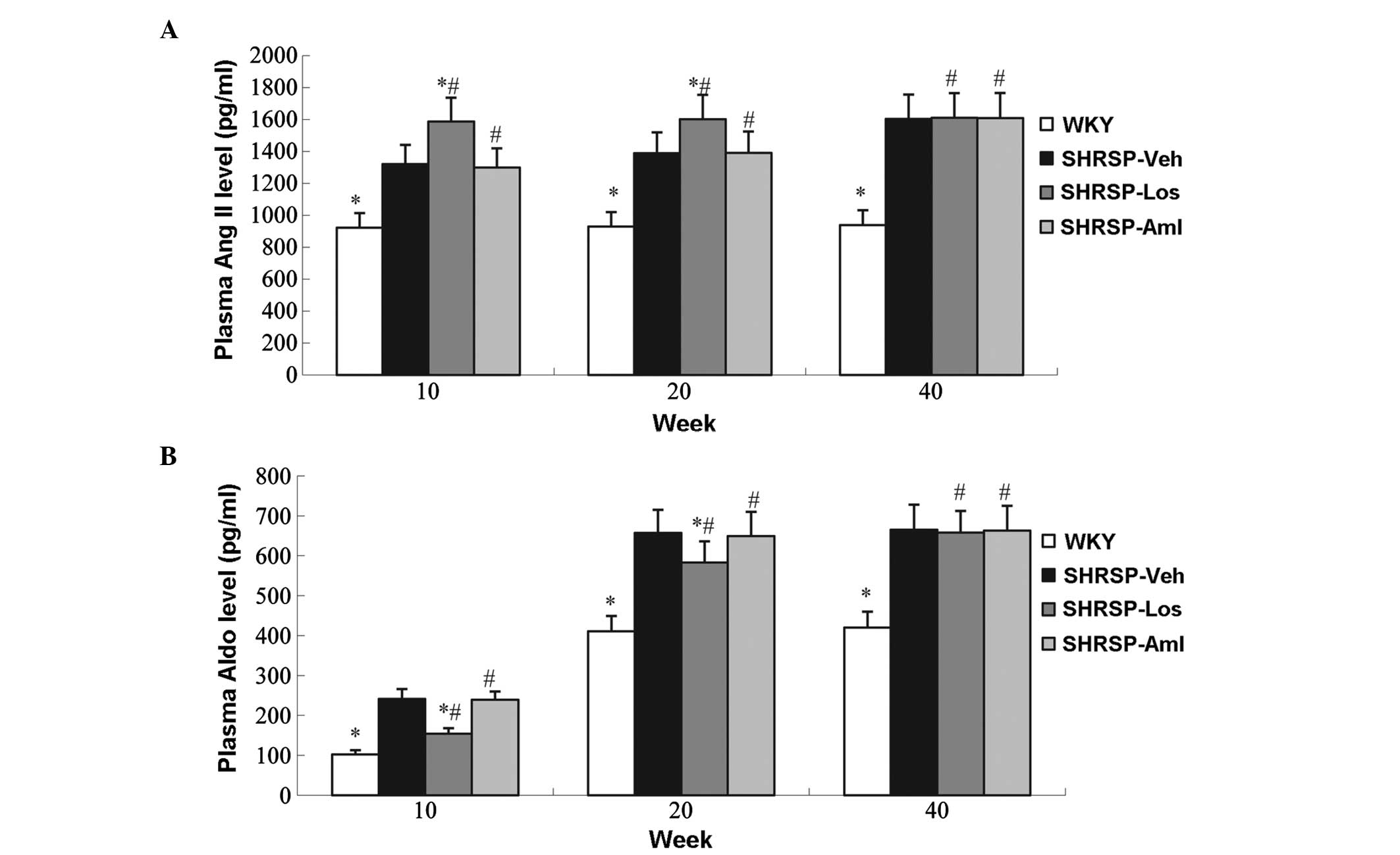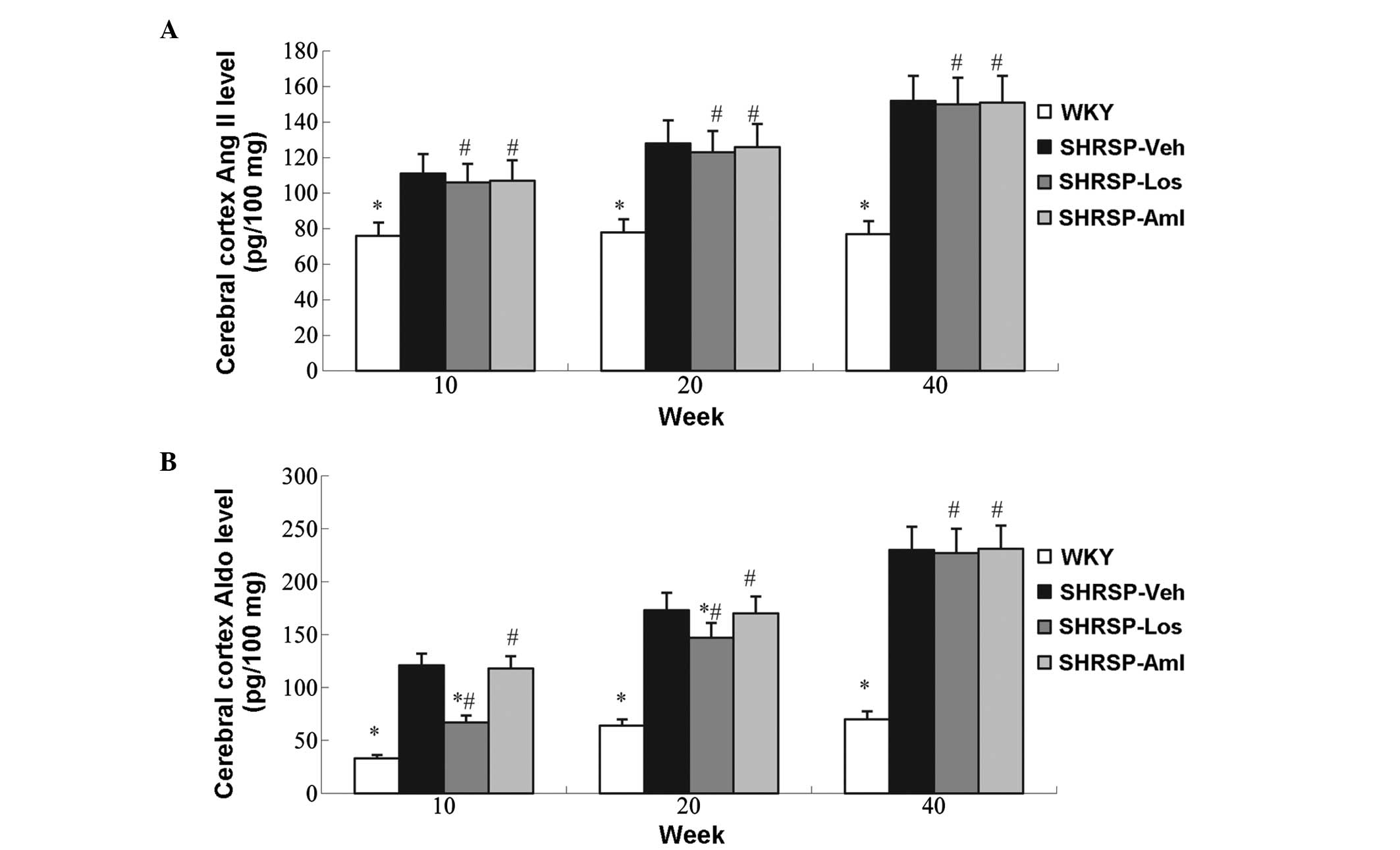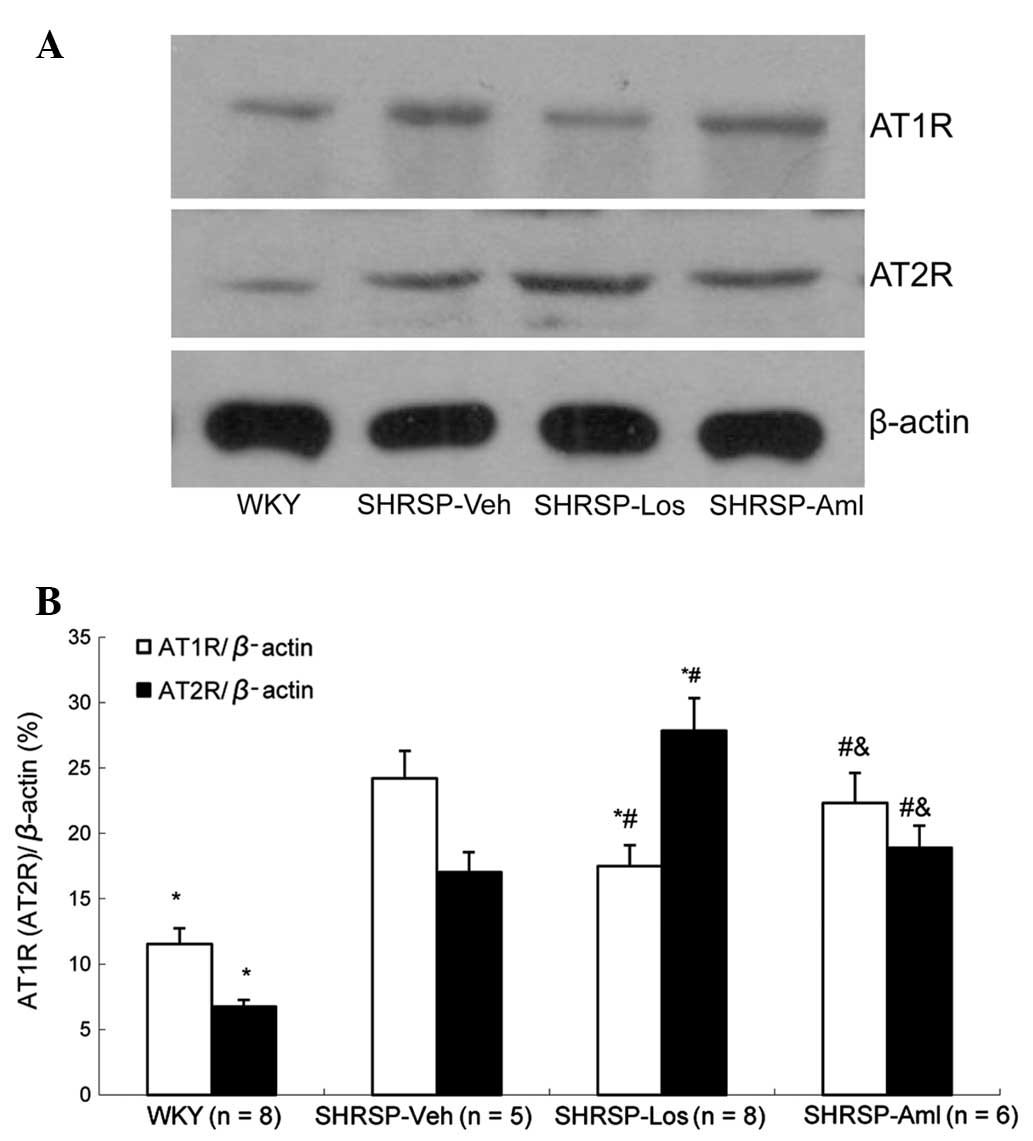Prehypertensive treatment with losartan, however not amlodipine, leads to long‑term effects on blood pressure and reduces the risk of stroke in spontaneously hypertensive stroke‑prone rats
- Authors:
- Published online on: December 4, 2015 https://doi.org/10.3892/mmr.2015.4641
- Pages: 1304-1310
Abstract
Introduction
Epidemiological studies have indicated that hypertension is an independent risk factor for stroke in patients with cardiovascular disorders. There is a significant positive correlation between blood pressure (BP) and stroke, even in the prehypertensive stage (1). A previous study demonstrated that extensive management of BP using antihypertensive medications significantly reduced the risk of stroke during the prehypertensive stage by 15–22% (2). Results from studies conducted using the spontaneously hypertensive stroke-prone (SHRSP) rat model have suggested that angiotensin receptor blockers (ARBs) significantly attenuated BP-induced brain damage by reducing the increased BP level (3,4). Among the ARB antihypertensive medications which are currently available, losartan has demonstrated clear efficacy in lowering morbidity and mortality from disorders such as myocardial infarction (MI) and stroke (5). In addition to its antihypertensive activity, losartan reverses left ventricle hypertrophy and atrial fibrillation (6). Together, these results suggest that losartan may prevent cardiovascular system deterioration through additional mechanisms.
Amlodipine is a long-acting calcium channel blocker (CCB) of the dihydropyridine class, and has been widely used as an antihypertensive agent in a clinical setting (7). While certain preliminary studies have indicated that CCBs may reduce stroke risk to a greater extent than ARBs (8), overall the data is inconclusive. A meta-analysis has indicated that compared with alternative antihypertensive drugs, amlodipine has the additional advantages of controlling central arterial pressure, and reducing the risk of stroke and MI (9). In addition to its antihypertensive effects, studies have suggested that amlodipine may significantly impact blood circulation in the brain by influencing calcium concentration in blood vessels, which may attenuate vasospasms and facilitate the reperfusion of ischemic areas in the brains of patients (10). However, the results of previous studies conflict with this conclusion (11,12). A previous study observed that losartan exhibited improved effects for the long-term control of BP in SHRSP rats, in particular following treatment discontinuation. However, it was not investigated whether prehypertensive intervention with either of these two agents was able to reduce the risk of stroke.
Therefore, in the present study the effects of losartan and amlodipine on hypertension and stroke were studied and compared in a spontaneously hypertensive rat model.
Materials and methods
Animal treatments
All animals (96 males; weight, 100–120 g) were purchased from the Shanghai Laboratory Animal Center Laboratory Animal Co., Ltd. (Shanghai, China). The animals were housed under conditions of a 12/12 h light/dark cycle, a temperature of 21±1°C and 60% humidity. Following acclimation for 1 week, 4-week old SHRSP rats were randomly assigned to 1 of 3 groups: Vehicle group, SHRSP-Veh (n=24); losartan group, SHRSP-Los (20 mg/kg/day; n=24); and the amlodipine group, SHRSP-Aml (10 mg/kg/day; n=24). Age- and gender-matched Wistar rats were assigned to a corresponding control group (WKY; n=24). Following 10 weeks of gavage administration of either losartan, amlodipine or the vehicle (0.9% normal saline, Sichuan Kelun Pharmaceutical Co., Ltd., Sichuan, China), the systolic blood pressure (SBP), clinical stroke score and levels of angiotensin II (Ang II) and aldosterone (Aldo) in the brain cortex, in addition to the expression of Ang II receptors type 1 and 2 (AT1R and AT2R, respectively) were measured. Amlodipine was purchased from Pfizer, Inc., (New York, NY, USA) and losartan was from Merck & Co., Inc. (Whitehouse Station, NJ, USA). The current study was approved by the Animal Ethics Committee of Fujian Medical University (Fuzhou, China) and conducted in accordance with institutional guidelines.
SBP measurement
Systolic pressure in the tail artery of animals in all groups was measured at 4, 10, 16, 20, 24, 28, 32, 36 and 40 weeks of dosing using a Rat Noninvasive Blood Pressure Measurement Analysis System (Chengdu TME Technology Co., Ltd., Chengdu, China).
Measurement of the mesenteric arterioles
Abdominal aortic cannulation was conducted and the blood vessels (8 µm; 1512 microtome; Leica Microsystems, Wetzlar, Germany) were perfused with formalin (ZSGB-BIO, Beijing, China) and fixed with paraffin (ZSGB-BIO) prior to staining with hematoxylin and eosin (H&E; Sigma-Aldrich, St. Louis, MO, USA). Images of the blood vessels were captured using a microscope (Olympus IX70; Olympus Corporation, Tokyo, Japan) The ratio of the thickness of the blood vessel wall to the lumen (W/L) in the third branch of the mesenteric arterioles was analyzed using Image Pro Plus Version 4.5 analysis software (B-Colored Multifunction Imaging Analyzing system; Media Cybernetics, Inc.). A 3 mm section of the third branch of the mesenteric arterioles was immersed in a bath solution containing 118 mmol/l NaCl, 4.7 mmol/l KCl, 2.5 mmol/l CaCl2, 1.2 mmol/l MgSO4, 1.2 mmol/l NaH2PO4, 20 mmol/l NaHCO3, and 11.1 mmol/l glucose (Beyotime Institute of Biotechnology, Shanghai, China; 95% O2 and 5% CO2 saturated; 37°C) and vasodilation and vasoconstriction were measured following treatment with gradually increasing concentrations of norepinephrine (10−10, 10−9, 10−8, 10−7, 10−6, and 10−5 mol/l; 100 µl; Tianjin Jinyao Amino Acid Co., Ltd., Tianjin, China), acetylcholine (10−10, 10−9, 10−8, 10−7, 10−6, 10−5 and 10−4 mol/l; 100 µl; Sigma-Aldrich) and sodium nitroprusside (10−10, 10−9, 10−8, 10−7, 10−6, 10−5 and 10−4 mol/l; 100 µl; China Resources Double-Crane Pharmaceuticals Co., Ltd., Beijing, China). A ML870 PowerLab 30 eight-channel recorder and LabChart software 6.0 (AD Instruments, Bella Vista. Australia) were used for data analysis.
Clinical stroke score
The clinical scores for stroke in each group were evaluated according to the symptomatological classification system (13), with minor modifications as follows: Level 0, normal activity; level 1, slightly reduced activity and/or slightly agitated; level 2, significantly reduced activity and/or highly agitated; level 3, lethargic and depression-like symptoms; level 4, paralyzed (either one or two sides).
Radioimmunoassay (RIA)
RIA kits for Ang II and Aldo were purchased from Beijing North Institute of Biological Technology (Beijing, China) and used according to the manufacturer's instructions. Briefly, samples of lysed tissue from 100 mg cortex pellet were boiled and then centrifuged at 1,000 × g at 4°C for 10 min. The supernatant fractions were used for measurements of Ang II and Aldo content in the brain cortex. For serum tests, 1 ml blood samples were extracted from the rats and stored in tubes containing heparin anticoagulant. The samples were then centrifuged at 1,000 × g at 4°C for 10 min, and the resultant serum samples were analyzed for levels of Ang II and Aldo according the manufacturer's instructions.
Western blot
Samples containing 100 mg cerebral cortex tissue were homogenized in lysis buffer (Beyotime Institute of Biotechnology), and equal amounts of total protein (1 ml) were applied to 10% SDS-polyacrylamide gels (Bio-Rad Laboratories, Inc., Hercules, CA, USA) and separated by electrophoresis. The proteins were then transferred onto a nitrocellulose membrane (EMD Millipore, Billerica, MA, USA), blocked with 5% nonfat milk in Tris-buffered saline containing 0.05% Tween-20 (TBST; Beyotime Institute of Biotechnology) prior to incubation with polyclonal rabbit anti-AT1R antibodies (1:500; ab18801; Abcam, Cambridge, MA, USA), and rabbit polyclonal anti-AT2R antibody (1:800; ab19134; Abcam) overnight at 4°C. Goat anti-β-actin antibodies were used as an internal control (1:1,000; sc-1616; Santa Cruz Biotechnology, Inc., Dallas, TX, USA). The membranes were washed 3 times with TBST, and then incubated for 1 h at room temperature with horseradish peroxidase-conjugated goat anti-mouse IgG (1,000; Santa Cruz Biotechnology, Inc.) and goat anti-rabbit IgG (1,000; Santa Cruz Biotechnology, Inc.) secondary antibodies. Following a further three washes with TBST, labeled proteins were visualized using enhanced chemiluminescence (sc-2048; Santa Cruz Biotechnology, Inc.) on high-performance chemiluminescence film (Eastman Kodak Company, Rochester, NY, USA). The band intensity was quantified by densitometry using image analysis software (Tanon Science & Technology Co., Ltd., Shanghai, China). Results for AT1R and AT2R were expressed as a ratio of AT1R or AT2R density divided by β-actin density.
Statistical analysis
Stroke scores were analyzed using the Kruskal-Wallis H test, followed by the Mann-Whitney U test. Comparisons between groups were made using the least significant difference test and SPSS software, version 16.0 (SPSS, Inc., Chicago, IL, USA). All data with the exception of stroke scores are presented as the mean ± standard error. P<0.05 was considered to indicate a statistically significant difference.
Results
Prehypertensive treatment with losartan resulted in long-term effects on BP and blood vessel pathophysiology in SHRSP rats
No significant difference in SBP was observed between rats treated with losartan and amlodipine. However, rats treated with losartan or amlodipine exhibited significantly reduced SBP values compared with rats in the SHRSP-Veh group (Fig. 1). Additionally, rats in the SHRSP-Los group maintained lower SBP readings for longer than their counterparts in the SHRSP-Aml group, SBP readings in the SHRSP-Los group were lower than those in the SHRSP-Aml group up to and including 36 weeks, following the suspension of drug treatment at 10 weeks (Fig. 1). To investigate the direct effects of losartan on blood vessels, the third branch of the mesenteric arterioles was studied using H&E staining. Higher W/L values were observed in the vessels of mice in the SHRSP-Veh and SHRSP-Aml groups (Table I), however, the values in the SHRSP-Los groups were higher compared with those in the WKY group. Losartan effectively reversed the narrowed lumen of blood vessels, however amlodipine did not (Fig. 2). Additionally, the systolic and diastolic function in each group was measured. Results demonstrated that compared with rats in the SHRSP-Aml and SHRSP-Veh groups, rats from the SHRSP-Los group exhibited thinner vascular walls and improved systolic and diastolic function following treatment with norepinephrine (Fig. 3), acetylcholine (Fig. 4) or sodium nitroprusside (Fig. 5).
Table IW/L in third branch of mesenteric arterioles of 40-week old rats in all groups (mean ± standard deviation). |
Prehypertensive treatment with losartan reduced the risk of stroke in SHRSP rats
Hypertension predisposes patients to the occurrence of stroke. Therefore, the long-term effects of losartan and amlodipine on the risk of stroke in rats were investigated in the present study. As presented in Table II, the mean clinical stroke score in the SHRSP-Los group was significantly reduced compared with the SHRSP-Aml (P=0.001) and SHRSP-Veh (P=0.002) groups, suggesting that prehypertensive treatment with Los may reduce the risk of stroke in these rats.
Prehypertensive treatment with losartan regulated the levels of Ang II and Aldo in SHRSP rats
The above data demonstrate that losartan is more effective than amlodipine in reducing BP and the risk of stroke, thus, the possible underlying mechanisms for this improvement were investigated. One possible explanation for the improved performance of losartan may involve BP-associated hormones, therefore the potential roles of Ang II and Aldo in these processes were investigated. Increased levels of Ang II and Aldo were observed in the SHRSP-Veh group compared with WKY animals (Figs. 6 and 7). Compared with the control group, losartan increased the serum levels of Ang II, and reduced levels of aldosterone; treatment with losartan in the cerebral cortex had no effect on Ang II levels, but decreased the levels of aldosterone. However amlodipine had no effect on Ang II and aldosterone levels (Figs 6 and 7).
Prehypertensive treatment with losartan regulated the expression of AT1R/AT2R proteins in SHRSP rats
Ang II and Aldo are the ligands of AT1R and AT2R, respectively. Ligand binding to AT1R and AT2R activates the receptors, and subsequently activates intracellular responses such as the stimulation of protein kinase C, which induces vasoconstriction (14). Therefore, it was suggested that these two receptors may be involved in these processes. To investigate this hypothesis, western blot analysis was conducted, which indicated a significant downregulation of AT1R expression and upregulation of AT2R expression in the SHRSP-Los group compared with the SHRSP-Veh group (Fig. 8). However, these alterations in the protein levels of AT1R and AT2R were not observed in the SHRSP-Aml group.
Discussion
As a common and chronic condition, hypertension places a significant burden on society. However, despite the development of numerous therapeutic strategies, hypertension remains an unsolved medical problem, due to the numerous associated complications. Studies have suggested that prehypertensive intervention may be beneficial for patient prognosis, thus represents novel targets to reduce the impact of this disease. In the current study, the effects of losartan and amlodipine on BP and stroke risk were compared in an SHRSP rat model. It was observed that all SHRSP animals developed high blood pressure at 10 weeks of age compared with zero in the WKY group. However, losartan and amlodipine significantly reduced the increase in BP whilst not resulting in a significant difference regarding anti-hypertensive capacity. Notably, following the suspension of the drug treatments, rats in the SHRSP-Los group demonstrated a slower rise in BP compared with rats in the SHRSP-Aml group. These data indicate that the two antihypertensive drugs exhibited comparable capacities in preventing the development of hypertension, however, losartan may have improved long-term efficacy for regulating BP. These results are consistent with those reported in previous studies (15,16). The potential underlying mechanisms for these results were investigated, with thinner vessel walls of the mesenteric arterioles in the SHRSP-Los group observed compared with the SHRSP-Aml and SHRSP-Veh groups. Furthermore, the mesenteric arterioles in rats in the SHRSP-Los group demonstrated improved systolic and diastolic function and reduced clinical stroke scores compared with the SHRSP-Aml group. These observations are consistent with a previous study in which visual observations and microscopic analysis observed tissue abnormalities in the brains of SHRSP rats treated with amlodipine, including loss of neurons and hemorrhage foci. However, these abnormalities were not observed in brain sections from Wistar control rats and SHRSP rats treated with losartan (17).
In the current study, investigations using radioimmunoassays and western blotting indicated increased Ang II levels and reduced Aldo levels in the SHRSP-Los groups, while there was no difference in Ang II and Aldo levels between the SHRSP-Aml and SHRSP-Veh groups. Furthermore, the expression of receptors for Ang II, AT1R and AT2R, were significantly altered following losartan treatment, however not following amlodipine treatment. These results suggest that the renin angiotensin system (RAS) may be activated by losartan, which may contribute to the therapeutic mechanism of this antihypertensive drug. This would be consistent with the theory of “RAS block memory” (17–20) in which Ang II is suggested to act as the conduit for translating blood vessel alterations into the pathogenesis of hypertension. As a blocker of Ang II receptors, losartan may prevent the further damage induced by constant stimulation of Ang II by reducing BP and rates of blood vessel remodeling.
Previous studies have reported that AT1R/AT2R expression levels were strongly correlated with an improved prognosis in patients with cardiovascular diseases, including hypertension and stroke (21–24). The current study observed a downregulation of AT1R protein expression and upregulation of AT2R protein expression in the SHRSP-Los group compared with the SHRSP-Veh group. AT1R/AT2R may mediate the neuroprotective effects of losartan in SHRSP animals. Whilst losartan blocks AT1R and thereby attenuates brain angiospasm, it may additionally improve blood supply to the brain via activating AT2R. A meta-analysis of clinical studies suggested that CCBs were more efficacious than ARBs in reducing the risk of stroke, which conflicts with the results of the present study (9). However, in the majority of human studies, the patient population consisted predominantly of elderly people, and such patients commonly have an underactive RAS system (25–27). Thus, during the prehypertensive stage, endothelial function in these patients may be compromised due to high RAS activity, which may result in a reduced response of the RAS system.
The were several limitations of the current study. Firstly, the current conclusion was reached on the basis of animal studies, and the results may not apply to human subjects. Secondly, the current study investigated a potential mechanism by focusing on the role of vasoconstricting hormones and provided evidence that Ang II and Aldo were responsible for the superior effects of losartan compared with amlodipine. However, additional biological pathways and molecules may affect these processes and further studies are required to fully elucidate the mechanisms involved.
Taken together, for the first time to the best of our knowledge, the current study demonstrated that the prehypertensive administration of losartan was more efficacious than amlodipine for the long-term maintenance of normal BP and brain function in SHRSP rats. Anti-hypertensive compounds that target the ABR system may exert improved efficacy by affecting Ang II and its corresponding receptors. While presenting novel evidence for the advantage of using losartan to reduce the risk of stroke in the prehypertensive stage, the present study additionally suggested that the brain-protective effect of losartan may be independent of its antihypertensive role.
Acknowledgments
The current study was supported by a grant from the National Natural Science Foundation of China (grant no. 81070207) to Dr Jinxiu Lin. The authors would like to thank Medjaden Bioscience Ltd. for assisting in the preparation of the manuscript.
References
|
Lee M, Saver JL, Chang B, Chang KH, Hao Q and Ovbiagele B: Presence of baseline prehypertension and risk of incident stroke: A meta-analysis. Neurology. 77:1330–1337. 2011. View Article : Google Scholar : PubMed/NCBI | |
|
Sipahi I, Swaminathan A, Natesan V, Debanne SM, Simon DI and Fang JC: Effect of antihypertensive therapy on incident stroke in cohorts with prehypertensive blood pressure levels: A meta-analysis of randomized controlled trials. Stroke. 43:432–440. 2012. View Article : Google Scholar | |
|
Takemori K, Ishida H and Ito H: Continuous inhibition of the renin-angiotensin system and protection from hypertensive end-organ damage by brief treatment with angiotensin II type 1 receptor blocker in stroke-prone spontaneously hypertensive rats. Life Sci. 77:2233–2245. 2005. View Article : Google Scholar : PubMed/NCBI | |
|
Hamaguchi R, Takemori K, Inoue T, Masuno K and Itox H: Short-term treatment of stroke-prone spontaneously hypertensive rats with an AT1 receptor blocker protects against hypertensive end-organ damage by prolonged inhibition of the renin-angiotensin system. Clin Exp Pharmacol Physiol. 35:1151–1155. 2008. View Article : Google Scholar : PubMed/NCBI | |
|
Dahlöf B, Devereux RB, Kjeldsen SE, Julius S, Beevers G, de Faire U, Fyhrquist F, Ibsen H, Kristiansson K, Lederballe-Pedersen O, et al LIFE Study Group: Cardiovascular morbidity and mortality in the Losartan Intervention For Endpoint reduction in hypertension study (LIFE): A randomised trial against atenolol. Lancet. 359:995–1003. 2002. View Article : Google Scholar : PubMed/NCBI | |
|
McLachlan J, Beattie E, Murphy MP, Koh-Tan CH, Olson E, Beattie W, Dominiczak AF, Nicklin SA and Graham D: Combined therapeutic benefit of mitochondria-targeted antioxidant, MitoQ10, and angiotensin receptor blocker, losartan, on cardiovascular function. J Hypertens. 32:555–564. 2014. View Article : Google Scholar : | |
|
Judd E and Jaimes EA: Aliskiren, amlodipine and hydrochlorothiazide triple combination for hypertension. Expert Rev Cardiovasc Ther. 10:293–303. 2012. View Article : Google Scholar : PubMed/NCBI | |
|
Messerli FH and Staessen JA: Amlodipine better than lisinopril? How one randomized clinical trial ended fallacies from observational studies. Hypertension. 48:359–361. 2006. View Article : Google Scholar : PubMed/NCBI | |
|
Wang JG, Li Y, Franklin SS and Safar M: Prevention of stroke and myocardial infarction by amlodipine and Angiotensin receptor blockers: A quantitative overview. Hypertension. 50:181–188. 2007. View Article : Google Scholar : PubMed/NCBI | |
|
He DH, Zhang LM, Lin LM, Ning RB, Wang HJ, Xu CS and Lin JX: Long-term prehypertension treatment with losartan effectively prevents brain damage and stroke in stroke-prone spontaneously hypertensive rats. Int J Mol Med. 33:301–309. 2014. | |
|
Julius S, Kjeldsen SE, Weber M, Brunner HR, Ekman S, Hansson L, Hua T, Laragh J, McInnes GT, Mitchell L, et al VALUE trial group: Outcomes in hypertensive patients at high cardiovascular risk treated with regimens based on valsartan or amlodipine: The VALUE randomised trial. Lancet. 363:2022–2031. 2004. View Article : Google Scholar : PubMed/NCBI | |
|
Ogihara T, Nakao K, Fukui T, Fukiyama K, Ueshima K, Oba K, Sato T and Saruta T; Candesartan Antihypertensive Survival Evaluation in Japan Trial Group: Effects of candesartan compared with amlodipine in hypertensive patients with high cardiovascular risks: Candesartan antihypertensive survival evaluation in Japan trial. Hypertension. 51:393–398. 2008. View Article : Google Scholar : PubMed/NCBI | |
|
Yamori Y, Horie R, Akiguchi I, Kihara M, Nara Y and Lovenberg W: Symptomatological classification in the development of stroke in stroke-prone spontaneously hypertensive rats. Jpn Circ J. 46:274–283. 1982. View Article : Google Scholar : PubMed/NCBI | |
|
Higuchi S, Ohtsu H, Suzuki H, Shirai H, Frank GD and Eguchi S: Angiotensin II signal transduction through the AT1 receptor: Novel insights into mechanisms and pathophysiology. Clin Sci (Lond). 112:417–428. 2007. View Article : Google Scholar | |
|
Lin JX and Lin LM: Prehypertensive treatment in spontaneously hypertensive rats: A comparison of losartan and amlodipine regarding blood pressure control and cardiovascular protection after drug withdrawal. Int J Cardiol. 137:S1322009. View Article : Google Scholar | |
|
Morton JJ, Beattie EC and MacPherson F: Angiotensin II receptor antagonist losartan has persistent effects on blood pressure in the young spontaneously hypertensive rat: Lack of relation to vascular structure. J Vasc Res. 29:264–269. 1992. View Article : Google Scholar : PubMed/NCBI | |
|
Harrap SB, Van der Merwe WM, Griffin SA, Macpherson F and Lever AF: Brief angiotensin converting enzyme inhibitor treatment in young spontaneously hypertensive rats reduces blood pressure long-term. Hypertension. 16:603–614. 1990. View Article : Google Scholar : PubMed/NCBI | |
|
Ishiguro K, Sasamura H, Sakamaki Y, Itoh H and Saruta T: Developmental activity of the renin-angiotensin system during the “critical period” modulates later L-NAME-induced hypertension and renal injury. Hypertens Res. 30:63–75. 2007. View Article : Google Scholar : PubMed/NCBI | |
|
Sasamura H, Hayashi K, Ishiguro K, Nakaya H, Saruta T and Itoh H: Prevention and regression of hypertension: Role of renal microvascular protection. Hypertens Res. 32:658–664. 2009. View Article : Google Scholar : PubMed/NCBI | |
|
Bergström G, Johansson I, Wickman A, Gan L and Thorup C: Brief losartan treatment in young spontaneously hypertensive rats abates long-term blood pressure elevation by effects on renal vascular structure. J Hypertens. 20:1413–1421. 2002. View Article : Google Scholar : PubMed/NCBI | |
|
Edvinsson L: Cerebrovascular angiotensin AT1 receptor regulation in cerebral ischemia. Trends Cardiovasc Med. 18:98–103. 2008. View Article : Google Scholar : PubMed/NCBI | |
|
Kasahara Y, Taguchi A, Uno H, Nakano A, Nakagomi T, Hirose H, Stern DM and Matsuyama T: Telmisartan suppresses cerebral injury in a murine model of transient focal ischemia. Brain Res. 1340:70–80. 2010. View Article : Google Scholar : PubMed/NCBI | |
|
Iwai M, Liu HW, Chen R, Ide A, Okamoto S, Hata R, Sakanaka M, Shiuchi T and Horiuchi M: Possible inhibition of focal cerebral ischemia by angiotensin II type 2 receptor stimulation. Circulation. 110:843–848. 2004. View Article : Google Scholar : PubMed/NCBI | |
|
McCarthy CA, Vinh A, Callaway JK and Widdop RE: Angiotensin AT2 receptor stimulation causes neuroprotection in a conscious rat model of stroke. Stroke. 40:1482–1489. 2009. View Article : Google Scholar : PubMed/NCBI | |
|
Denker MG and Cohen DL: What is an appropriate blood pressure goal for the elderly: Review of recent studies and practical recommendations. Clin Interv Aging. 8:1505–1517. 2013.PubMed/NCBI | |
|
Umemoto S, Ogihara T, Rakugi H, Matsumoto M, Kitagawa K, Shimada K, Higaki J, Ito S, Suzuki H, Ohashi Y, et al Combination Therapy of Hypertension to Prevent Cardiovascular: Effects of a benidipine-based combination therapy on the risk of stroke according to stroke subtype: The COPE trial. Hypertens Res. 36:1088–1095. 2013. View Article : Google Scholar : PubMed/NCBI | |
|
Aronow WS: Hypertension-related stroke prevention in the elderly. Curr Hypertens Rep. 15:582–589. 2013. View Article : Google Scholar : PubMed/NCBI |



